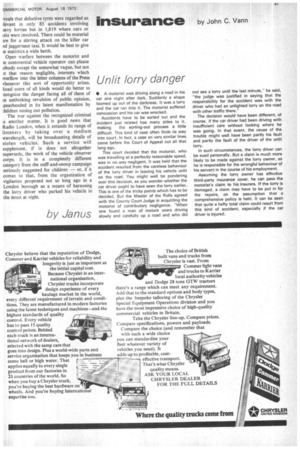topic
Page 48

Page 49

If you've noticed an error in this article please click here to report it so we can fix it.
Lorry spotters
A WRITER in an educational magazine has come up with a suggestion that children armed with air pollution kits should track down smoking lorries and report them to the authorities. At the other extreme of the age groups, a retired professor recently laid information against a number of operators whose vehicles he claimed had caused annoyance; and had a field day in the courts until one of the accused took it into his head to plead not guilty.
Carrying on the good work, a Sunday paper has been sending its reporters to likely , places where they can take particulars of a dozen smoking lorries at a time. When asked for comments, the owners seem remarkably tolerant; whereas the Chief Constable of Northampton has been reported as commenting that the use of children would be a throwback to the Nazi era.
This was worth saying. There must come a time when operators decide to make a stand against the self-appointed guardians of purity. Events elsewhere have shown the risk of encouraging children to identify public enemies.
Attdcks in the Press reflect a change in the type of subject likely to excite readers. In a permissive society, the scope is reduced for the scandalous story which can be combined with a prudish condemnation of such goings on. Practices once reported in lurid detail now find a place in the school textbooks. What. the butler saw would be considered tame in a film accepted for general showing. The purveyors of cant must look for another target for their ambivalent approach.
TO titillate They seem to have found it in the so-called juggernaut or killer lorry. All they have to do is to leaf through the long lists of possible faults in the Goods Vehicle Testers' Manual, or the even longer list of possible offences against a variety of regulations, select one that seems likely to titillate the public, and start writing — remembering to add an occasional sprinkling of random statistics and a flavouring of moral indignation.
The subject may be the tanker with the dangerous or inflammable load. This in itself is guaranteed to make the flesh creep. Another example which has recently been explored in a notorious article is the overloaded lorry. Fortunately, the highly coloured account does not seem to have been taken too seriously. Otherwise we should have the spectacle of cars huddled together on the roads like sheep waiting for the murderous wolf to strike.
Noteworthy in this particular article was the pyrotechnical shower of statistics which were either inaccurate or had no relevance to the subject. When such a bravura display has been put on for the benefit of a readership of several millions, it is disappointing that the author overlooked the one figure that might have lent at least a spurious conviction to his theme.
Plain for all to see in the official road accident statistics from the Department of the Environment — and the Scottish Development Department and Welsh Office for good measure — is that during 1970 the load on 220 heavy goods vehicles (that is to say lorries over 3 tons unladen) had a bearing, according to the police, on accidents resulting in injury. The figure for cars and taxis was only 80. In fact, if all vehicles were taken into account, including motor cycles, passenger service vehicles and vans, the heavy lorry still had a responsibility of nearly 50 per cent.
It would be spoiling the fun to suggest that normally the goods vehicle is the only one to carry what can be described as a load. The figure of three for psvs speaks for itself. But this is mere chop logic. A ready-made stick with which to beat the lorry operator and driver has somehow been overlooked.
The juggernaut taxi Perhaps the neglect was not unintentional. The same table from which the damning statistic has been gleaned :veals that defective tyres were regarded as :levant in only 85 accidents involving tavy lorries but in 1,819 where cars or xis were involved. There could be material tre for a stirring attack on the killer car ad juggernaut taxi. It would be best to give te statistics a wide berth.
Open warfare between the motorist and te commercial vehicle operator can please obody except the somewhat vague, but not that reason negligible, interests which )verflow into the letter columns of the Press vhenever this sort of opportunity arises. load users of all kinds would do better to -ecognize the danger facing all of them of tn unthinking revulsion of public opinion, ;pearheaded in its latest manifestation by thildren nosing out pollution.
The war against the recognized criminal Ls another matter. It is good news that Radio London, when it extends its range of listeners by taking over a medium wavelength, will be broadcasting details of stolen vehicles. Such a service will supplement, if is does not altogether supersede, the work of the vehicle observer corps. It is in a completely different category from the sniff-and-snoop campaign seriously suggested for children — or, if it comes to that, from the organization of vigilantes proposed not so long ago in a London borough as a means of harassing the lorry driver who parked his vehicle in the street at night.
by Janus


































































































